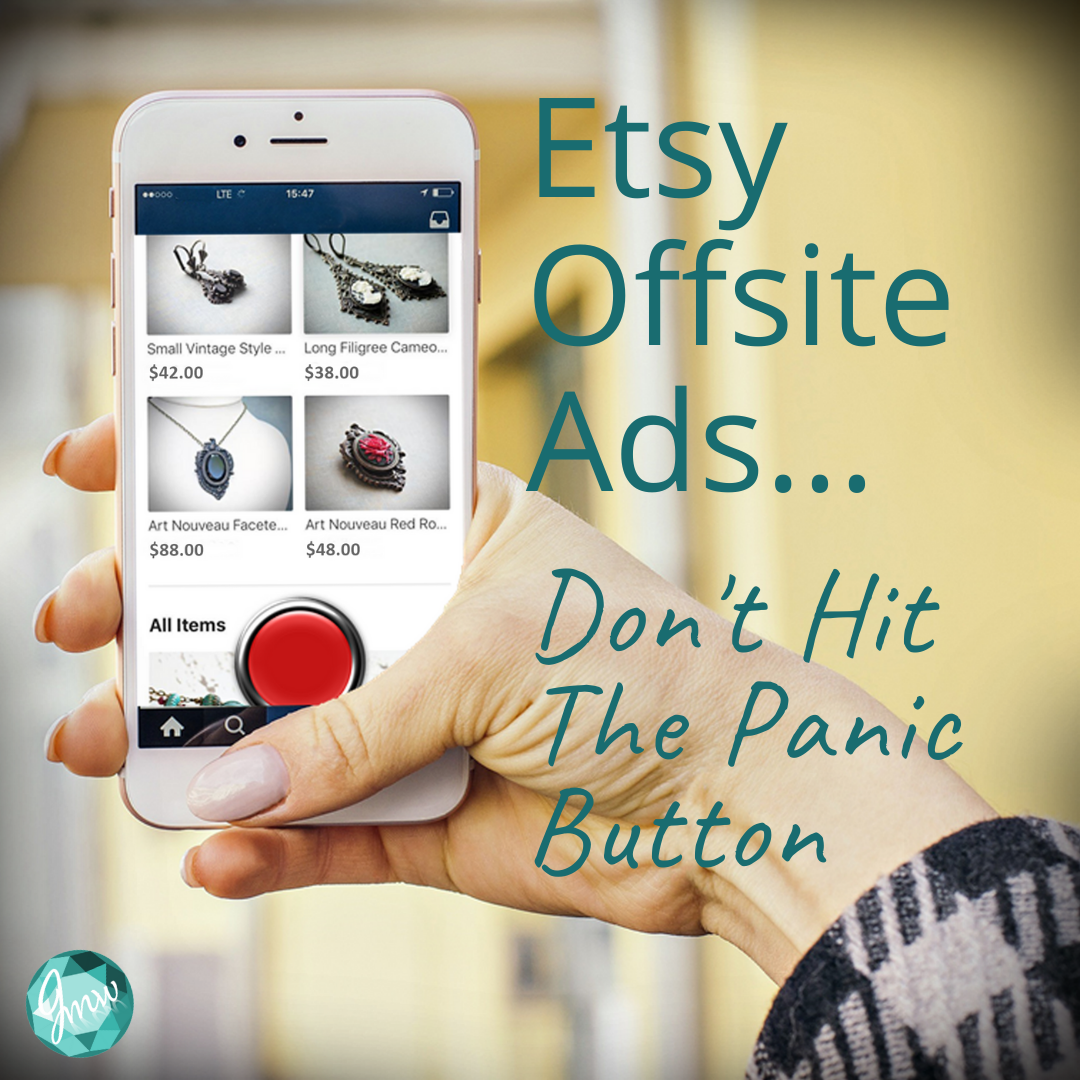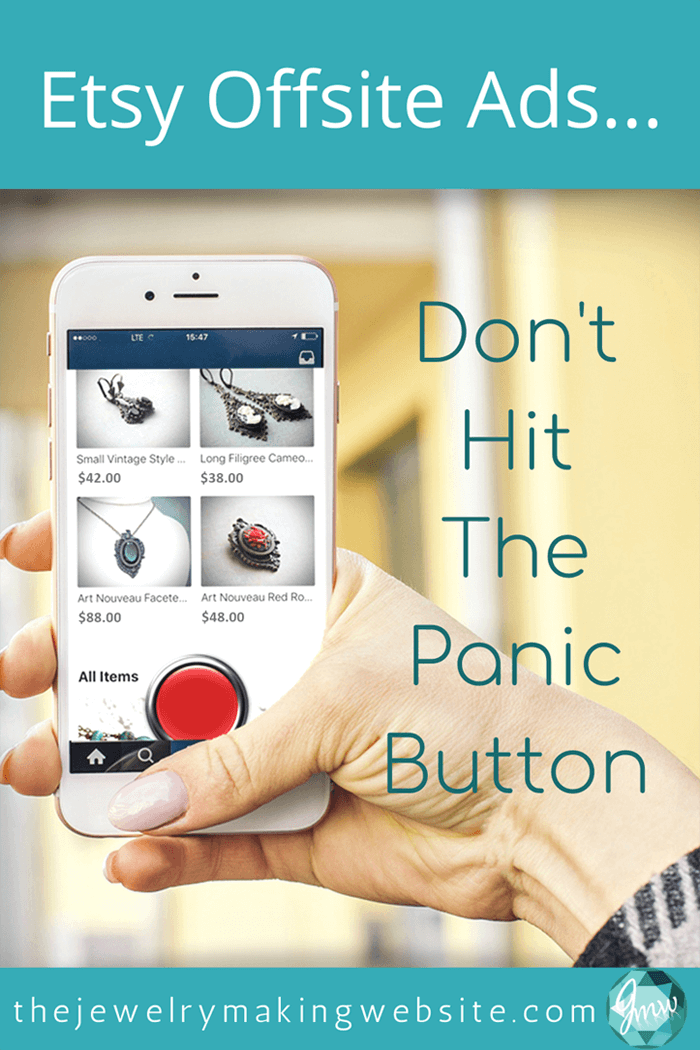etsy advertising...
Why You Shouldn't Hit the Panic Button on Offsite Ads
The recent Etsy advertising news has a lot of sellers talking about how offsite ads are going to affect their profits. There are loads of Etsy sellers chiming in on how put off and annoyed they are about this bold new move.
I totally understand there are some legitimate concerns and I won’t profess to know the innuendos and intricacies of individual Etsy shops when it comes to margins and pricing challenges, but I will say... Let’s not push the panic button!
etsy advertising...
8 reasons to shift your thinking regarding offsite ads

Let’s Put it in Perspective - Sure, I get it. If you are already ringing in the sales, you might be mad because you’ve got a system that works and you don’t want to hand over a bigger slice. And if you’re struggling, you resent the fact that you’re already challenged to make ends meet and now you’re going to be paying more.
But let’s look at it in perspective. Etsy is not going to take 12 to 15 percent of your overall sales. Etsy estimates that only about 10 percent of your sales will result from offline ads. This means, in reality, you will only pay the Etsy advertising fee on a small portion of your sales and they will likely be sales you wouldn’t have otherwise seen.
Secondly, you really can’t factor in credit card processing fees into the "whole-cut" equation. For the most part, you will likely pay around three percent through any payment gateway on your own website. Even if you use a payment processing provider that offers better rates, generally you’ll pay a larger monthly fee for that service, in addition to your percentage rate.
Lastly, you pay nothing. Nada. Zilch. That’s zero, if you don’t make a sale through offline ads. And if you’re paying nothing, you have to be asking yourself “why are my ads being served, yet people aren’t clicking on, or buying my products?”
Hello!... that’s a pile of valuable information in itself (we’ll get to that one later).
The Old Days - I come from the good old days when a small business owner didn’t have a hope in “hello I’m over here” of being found unless they had the big bucks to spend on advertising. Never mind advertising, these were the days when you couldn’t afford a photographer, typesetting, and paste-up and layout, let alone printing your cute little postcards to hand out in the street.
You heard me right, that old $80,000 Compugraphic typesetting machine made designing marketing material super expensive (yes, I’m that old). Honestly, when they talk about leveling the playing field, we are living the dream right now.
The hired photographer has become the DIY smart phone. The typesetter (turned desktop publisher) has become you on Canva. And handing out printed color postcards in the street has become Pinterest.
Not too long ago, before the internet was a thing, people had to spend more money on advertising and promoting business. Whether it was local newspaper ads, magazine ads, direct mail, or radio and television ads, the cost of getting your message out there was high. Not to mention, most of it wasn’t even targeted advertising.
We have become accustomed to the new “free” age of the internet, but smart marketers know that you still have to spend a little to grow a business. Only now, your dollar goes much further because you can reach highly-qualified buyers at a fraction of the cost.
Unlike television advertising which requires a huge budget and casts a wide net to reach a large audience, online advertising is the cat’s meow because it can be incredibly targeted. For this reason alone, I believe the Etsy advertising fee will be worthwhile. So let’s circle round to that last point on, who is, or who isn’t, going to click on your potential ad and buy.
Proactive vs Reactive - Here’s were I think we can all do better. I know it’s easy to react and think that Etsy is just trying to take a bigger piece of the action, but here’s why I think it’s not about that. The Etsy advertising fee is set up to only charge you if you get the sale which, in my mind, is going to provide you with lots of valuable information.
Targeted advertising is one of the most effective ways to test price points, product photos, product descriptions (aka sales copy), product titles, and keywords (tags). Etsy provides some pretty darned good analytics and you can bet they haven’t planned this move without a deep-dive into how these analytics are going to help you as a seller.
If you’re not getting some sales from offline ads, you have to ask yourself why. It can only mean one, or a combination, of the five fore mentioned. Perhaps your price points are too low, dragging down the overall positioning of your products, or maybe your photos aren’t doing your beautiful work any justice. That takes us to our next point.
Analytics and Results - Getting your product out there with some targeted ads will mean that you’ll have first-hand information right in your Etsy shop so you can start tweaking your listings.
The rule goes, change only one item at a time so you can measure the results. If you see that one listing was clicked on eight times from an offline ad but didn't result in a sale, you might want to try changing the copy in your product description. Getting the click means that your product photo probably sparked some interest, but you still weren’t able to convert a visitor into a buyer.
Naturally, it'll take some time to start seeing enough data in your analytics for you to begin putting together the why behind the ads’ success, or lack there of. With time, you'll be able to play around, making smart adjustments. Etsy advertising, especially offline ads, will produce valuable data that you can use to improve your listings and grow your sales.
The information you can retrieve from visitors who land on your shop from outside the Etsy platform, can then be used for attracting those clicks and buys from inside the platform. All-round, I believe, it’s going to offer lots of juicy feedback if you are willing to spend time in your analytics and put your findings into strategic action.
Do the Math - How the advertising fees affect you depends largely on what type of products you sell and your price points. If you’re selling digital products, you probably have already thought of tweaking your prices if need be, but if you’re selling vintage, or supplies, you’re likely worried about margins and whether the new fee will lower your profits.
Likewise, if your products are handmade and labor-intensive, you might also have concerns. The best way to look at this is with a shift in mindset and a focus on advertising as an investment.
Although you may have not asked for the opportunity, it... has come to you. You can either look at it as a possible loss of revenue, or as the opportunity to scale up your business with some strategic decision-making around your pricing and presentation.
For example, if your sales climb to $800 a month, Etsy estimates 10 percent of those sales will be from offsite ads, costing you around $12 in advertising. If your average sale is $32, then you’re selling about 25 items a month. Increasing your per-item price by 80 cents would more than cover the cost of advertising.
Alternatively, if you increased your shipping by 60 cents, you would also cover your Etsy advertising. Or, you could do a fifty-fifty split, adding a sliver to the product prices and the balance to the shipping.
What about free shipping? Perhaps you adopted the free shipping option when that was introduced a while back. In this case, you may want to either wait and see how the advertising sales affect your monthly income, or simply increase your prices a little. Another option is to slowly introduce new items at prices that factor in the new cost of Etsy advertising. To read more about the offsite Etsy advertising fee visit here.
The Cost of Doing Business - I know that this whole offsite Etsy advertising fee may have you frustrated, or even feeling you are caught in a system that doesn’t work for you, but I want to put it out there that changing with the times is, and always has been, part of the cost of doing business.
Etsy didn’t get to be the success it is today by staying in the same place. It’s far too early to estimate the full scope of offline ads and the opportunity that can potentially unfold. I, for one, was excited by the prospect given the results I have already seen elsewhere with targeted ads. I say, wait and see.
Crossover Customers - There is no doubt that shops with high-volume sales will probably be most affected by the offsite Etsy advertising fee and I get that there is some concern over having crossover customers. Meaning, customers you have already sold to might see offline ads and revisit your shop and make a purchase. This suggests that, even if you've sold to them in the past, you may be paying Etsy to sell to them through an ad.
Consider two things in this regard. First, even large companies advertise to their own customers to bring them back to make a purchase. Again, this is the cost of doing business and it's proven to increase revenue. In all fairness, customers who return to your shop, via an offsite ad, would not necessarily make a purchase had they not been reminded of your product through an ad.
Second, remember we're talking about a massive potential audience. You really have to ask yourself what the likelihood is your current buyers are going to be the exact buyers that are targeted in offline ads. In the end, it will be your analytics that tell you whether offsite Esty advertising is bringing in more new buyers from outside of Etsy.
Choices and Control - The reason most people set up a shop on Etsy is that it has a built in, primed audience, and for that you pay a price. That price needs to be stacked up against the cost to bring in the same kind of sales via your own, or alternative, platforms.
How much will it cost you to bring in the same sales on your own website? Selling on Etsy doesn’t mean you can’t do your own thing on your own website. I do both and each one serves a different purpose. They are distinctly different and each require different strategies.
I liken this to craft shows. Often exhibitors get upset by craft show rules and contracts. If a show contract stipulates that you must accept a customer return during the duration of the show, then you have to decide whether you align with that if you want to exhibit at that particular show.
When a show promoter includes an exclusivity clause in their contract, it’s up to us to decide whether that show is worth committing to, exclusively, for the period stipulated in the contract. Of course we all want control, but when we're on someone else's turf, we will always see changes occur as new possibilities present themselves.
We are not victims here. Business has always, and will always, come with responsibilities and challenges that require us to be strategic in our decision-making. I think, if used properly, the new Etsy advertising with offsite ads will bring lots of opportunity, especially for sellers who have covered all the must-haves with their photos, sales copy, and strategic pricing.

New! Comments
Have your say about what you just read! Leave me a comment in the box below.